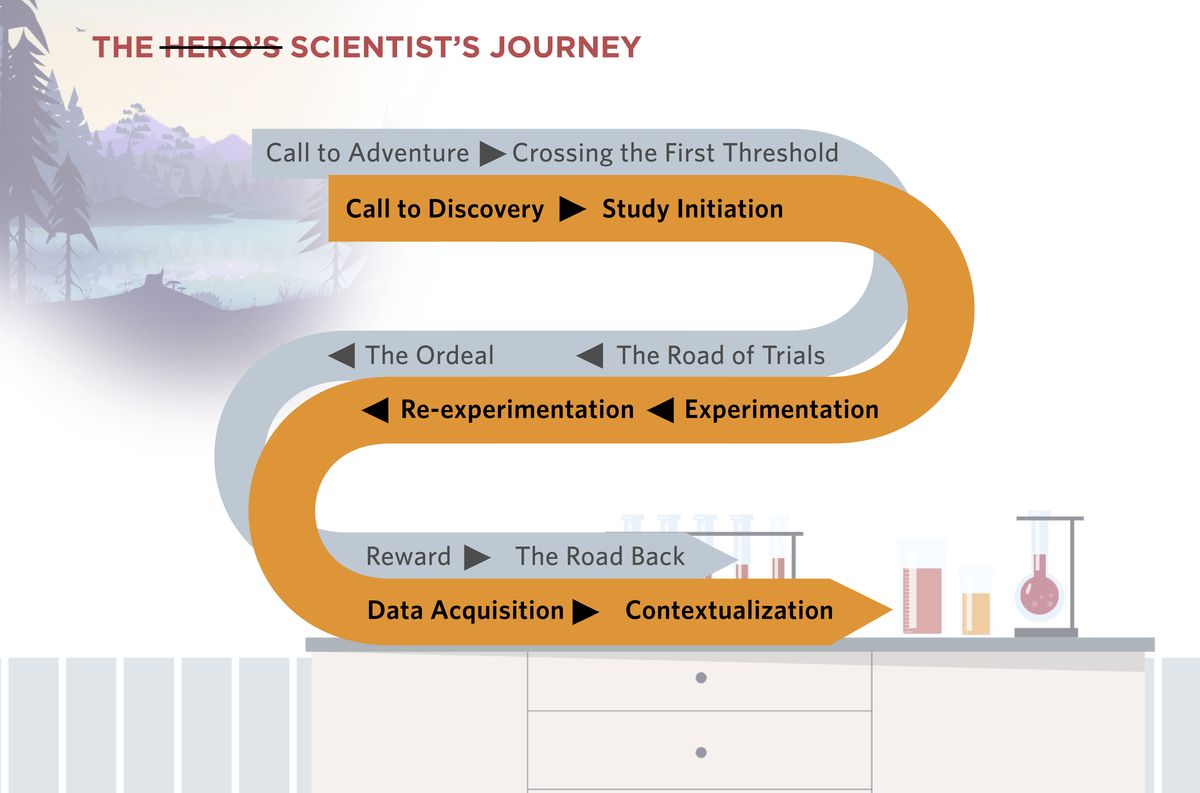
To many, “scientist” and “storyteller” stand diametrically opposed to one another. One deals in cold hard facts, the other spins fiction. However, the limitations of the knowledge deficit model of communication, where the intended audience is bombarded repeatedly with most rigorous scientific evidence available, has been made evident by numerous studies.1 Science is not best communicated through a rigid, robotic recitation of data points and their corresponding interpretations and implications. To be effective communicators, scientists must be storytellers.2
What Is a Scientific Narrative?
The main ingredient to an engaging story is the narrative—the descriptive account of connected events that the author uses to convey their intended message to the audience. The narrative in a scientific story aims to contextualize generated data2 in a way that answers the following questions.
- Why did the authors look for more information in this area?
- How did the authors go about generating data?
- What do the authors think their data means?
- How do the authors fit their work within what is already known?
- What do the authors think are the greater implications of their study?
With these questions in mind, a scientific narrative contains three major phases: establish, prove, and convince.
The Parts of a Scientific Narrative
Establishing Rationale
The establish phase is where authors lay out why they undertook the study in the way that they did. Within a conventional manuscript structure, the establish phase largely comprises the introduction section, although the methods section may also be involved. Here, authors must introduce the problem that they are trying to solve, the obstacles in their way, and how prior work—whether by the authors themselves or by others—has led them to their current position.
Using a recently published article3 in Science Immunology by immunologist Bali Pulendran’s group from Stanford University as an example, the first sentence of the first paragraph immediately lays out the problem facing scientists in their field, while the second sentence explains why that problem needs to be solved:
The stimulation of broad and durable immunity is one of the major challenges in the field of vaccinology. As seen with the emergence and evolution of the Omicron variants of severe acute respiratory syndrome coronavirus 2 (SARS-CoV-2), rapidly mutating viruses can effectively evade antibody responses induced by vaccination.
The remainder of the first paragraph then explains what the authors are investigating (memory B cells) and why they are investigating it (they serve as a second line of defense for developing broad and long-lasting immunity).3
Within a single paragraph, the authors have clearly outlined the problem that they are trying to solve and a potential solution. The subsequent two paragraphs go on to explain the obstacles that they face (how adjuvants affect memory B cells in humans and whether adjuvanted recombinant SARS-CoV-2 vaccines induce potent memory B cell responses in humans are both unknown) and transition those obstacles into the rationale for their study (to investigate the effect of the adjuvant AS03 on modulating the human B cell response to a plant-based virus-like particle vaccine for SARS-CoV-2).3

Building Proof
The prove phase is where authors showcase how they addressed the problem that they built up during the establish phase. This phase not only entails presenting data-based evidence, but also the rationale behind the selected experimentation strategy. Why the author chose a particular assay is just as important as the data that the assay generated. To that point, many journals today choose to omit the materials and methods section within published manuscripts and jump straight from the introduction to the results. This forces authors to explain their data and discuss why they sought to generate it in the first place—in other words, building a narrative.
Again, the Science Immunology manuscript3 by Bali Pulendran’s group is a fine example of what this means in practice. In it, the authors repeatedly explain their experimental rationale before outlining the key parameters of their assays and showcasing their data:
To assess the effect of AS03 on the serum antibody responses, we measured binding antibody titers against the SARS-CoV-2 wild-type (WT, Wuhan) strain and seven variants using a commercially available multiplexed immunoassay from MesoScale Discovery (MSD). CoVLP+AS03 notably enhanced the magnitude of binding antibody responses to WT SARS-CoV-2 and all seven variants when compared with immunization with CoVLP alone at both day 42 (Fig. 1C) and day 201 (Fig. 1D).
Strikingly, the authors also take care to provide additional detail when moving from one major topic to another. They summarize the findings of the previous section and explain how those findings precipitated the transition to the subsequent topic:
Our results so far demonstrate that AS03 enhances the magnitude of serum antibody, T cell, and memory B cell responses to spike protein. All vaccination regimens induced limited cross-neutralization breadth in serum against the BA.5 variant at day 201 (Fig. 1F). Thus, we sought to investigate the effect of AS03 on the breadth of antibodies encoded in the antigen-specific memory B cell compartment. To this end, we generated monoclonal antibodies (mAbs) using the BCR sequences of sorted single spike-specific memory B cells from each group of vaccinees. A total of 230 mAbs were generated from all immunization groups combined, including mAbs from both day 42 and day 201 time points (Fig. 4A). Of these, 34, 149, and 47 mAbs were isolated from the CoVLP (eight individuals), CoVLP+AS03 (17 individuals), and mRNA-1273 (six individuals) groups, respectively (Fig. 4A).
These details link the data together into a cohesive sequence. The authors’ findings build upon each other rather than existing as a loose assortment of facts. This not only helps the audience understand the researchers’ logic, but also brings them into the scientists’ journey of discovery, creating a notion of anticipation.
Making a Convincing Argument
Finally, the convince phase is where the author must tie the narrative together. Having explained the why and the how, the scientist must now explain what it all means and why it matters. In this phase, the author outlines the implications of their findings, where their findings fit within existing frameworks, and what the next steps should be. Here, it is important to circle back to all of the questions initially raised during the establish phase and outline how the new data addresses them. The author should take care to minimize the introduction of new questions or trains of thought—new information should be placed within the context of the generated data and resulting interpretations.
While the discussion section comprises most of the convince phase, strategic sentences can be sprinkled throughout the results and even the methods to explain the authors’ rationale as the audience moves through the study. The convince phase should also not shy away from discussing a study’s limitations or drawbacks. A scientifically-inclined audience generally understands that no study is flawless, and that every study will be hampered by a scarcity of resources (including time), logistical challenges, or the need to restrict the scope. Therefore, any attempt to obscure or omit these drawbacks, rather than presenting a pristine study, invites suspicion instead.
Why Narrative Is Necessary
Francis Bacon, whose work was instrumental in the development of the modern scientific method, notes that experimentation without direction is “mere groping in the dark.”4 Instead, science relies on thematic organization and a logical narrative flow:
On the contrary, the real order of experience begins by setting up a light, and then shows the road by it, commencing with a regulated and digested, not a misplaced and vague course of experiment, and thence deducing axioms, and from those axioms new experiments…4
However, the idea of having a narrative has a bad reputation in scientific circles. Narratives, whether for fiction, politics, or marketing, highlight the biases of the author, and so scientists are taught to shed narratives in the spirit of eliminating bias in their reporting.2
But the nature of communication is inherently biased. How one communicates is colored by the experiences of the teller, the perspectives and knowledge of the recipient, and the time and space allotted by both the chosen medium and the attention span of the intended audience. If anything, removing all of this information from the manuscript introduces bias and promotes the creation of a rigid dogma.5
Bias should not be confused with dishonesty. As long as there is no falsification, whether through addition or omission, a scientific story is just as valid as numbers on a spreadsheet. If anything, to strip a scientific story of its narrative is to strip it of its soul—to strip it of the authors’ motivations, inspirations, and struggles.
Looking for more information on scientific writing? Check out The Scientist’s TS SciComm section. Looking for some help putting together a manuscript, a figure, a poster, or anything else? The Scientist’s Scientific Services may have the professional help that you need.
- Jones MD, Anderson Crow D. How can we use the ‘science of stories’ to produce persuasive scientific stories? Palgrave Commun. 2017;3:53.
- Padian K. Narrative and "anti-narrative" in science: How scientists tell stories, and don't. Integr Comp Biol. 2018;58(6):1224-34.
- Grigoryan L, et al. AS03 adjuvant enhances the magnitude, persistence, and clonal breadth of memory B cell responses to a plant-based COVID-19 vaccine in humans. Sci Immunol. 2024;9(94):eadi8039.
- Bacon, F. Novum Organum, by Lord Bacon. ed. Joseph Devey. New York: P.F. Collier; 1902.
- Sheehan RJ, Rode S. On scientific narrative: Stories of light by Newton and Einstein. J Bus Tech Commun. 1999;13(3):336-58.
